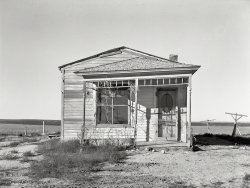
MAY CONTAIN NUTS

Search Shorpy
SHORPY ART

Framed or unframed, desk size to sofa size, printed by us in Arizona and Alabama since 2007. Explore now.
Join and Share
Ad-Free Shorpy
Shorpy is funded by you. Patreon contributors get an ad-free experience.
Learn more.

Recent comments
- Freeze Frame
- Texas Flyer wanted
- Just a Year Too Soon
- WWII -- Replacing men with women at the railroad crossing.
- Yes, Icing
- You kids drive me nuts!
- NOT An Easy Job
- I wonder
- Just add window boxes
- Icing Platform?
- Indiana Harbor Belt abides
- Freezing haze
- Corrections (for those who care)
- C&NW at Nelson
- Fallen Flags
- A dangerous job made worse
- Water Stop
- Passenger trains have right of way over freights?
- Coal
- Never ceases to amaze me.
- Still chuggin' (in model form)
- Great shot
- Westerly Breeze
- For the men, a trapeze
- Tickled
- Sense of loneliness ...
- 2 cents
- Charm City
- What an Outrage
- Brighton Park
Member Photos
The Shorpy
Print Emporium
Print Emporium
Search Shorpy
Search results -- 30 results per page
- Fast Food: 1938
- ... Arkansas." View full size. 35mm nitrate negative by Russell Lee for the FSA.
NACA What does NACA stand for?
N.A.C.A. From ... Posted by Dave - 03/23/2008 - 4:01pm -
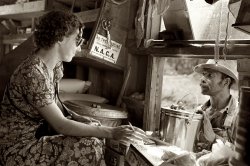
- Sunnyside Mill: 1940
- ... attract the mine and mill operators." Acetate negative by Russell Lee for the Farm Security Administration. View full size.
I guess that ... Posted by Dave - 09/07/2018 - 2:23pm -
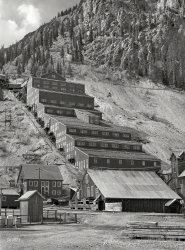
- Family Portrait: 1936
- ... combined." View full size. Medium format negative by Russell Lee for the Resettlement Administration.
Yvonne That's my wife's name. ... Posted by Dave - 09/09/2011 - 7:04pm -
![Family Portrait: 1936 December 1936. Dickens, Iowa. "Part of the L.H. Nissen family of ten living in a three-room shack. Rest of family at school. The whole house was of unusually high humidity. The wife said they could not dry out the bedding because of the poor ventilation. This is the living room and kitchen combined." View full size. Medium format negative by Russell Lee for the Resettlement Administration.
YvonneThat's my wife's name. But I'm more curious about the tiger attack.
[The Yvonne on the wall was one of the Dionne quintuplets. - Dave]
Tiger Attacks Man!Can you post a closeup of the Des Moines Register?
[Click to enlarge! - Dave]
Wet britchesIt looks like the little fellow on the right has wet pants. From the looks of his sister's face, her dress is probably wet too.
(The Gallery, Rural America, Russell Lee)](https://www.shorpy.com/files/images/8b29958u.thumbnail.jpg)
- Holsum White: 1940
- ... Farms. Pinal County, Arizona." Acetate negative by Russell Lee for the Farm Security Administration. View full size.
May I say ... Posted by Dave - 12/01/2020 - 11:05am -
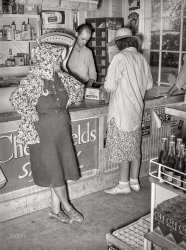
- Federal Street: 1941
- ... section of Chicago." Medium format acetate negative by Russell Lee. View full size.
San Francisco inspired This could be labeled ... Posted by Dave - 09/14/2018 - 8:47pm -
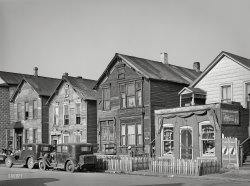
- The Summer of ’41
- ... swimming pool in Caldwell, Idaho. 35mm nitrate negative by Russell Lee, Farm Security Administration. View full size.
Neat I live in ... Posted by Dave - 06/30/2009 - 2:56pm -
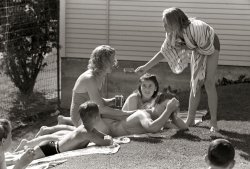
- Well-Preserved: 1940
- ... goods. Snowville, Utah." Medium format acetate negative by Russell Lee for the Farm Security Administration. View full size.
Undoubtedly, ... Posted by Dave - 09/12/2020 - 12:11pm -
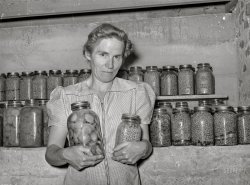
- Jumpers: 1941
- ... full size. Printed from a 35mm nitrate negative shot by Russell Lee.
U.S. Mail I like how the Postal Station says "For Letters."
... Posted by Dave - 09/08/2011 - 7:07pm -
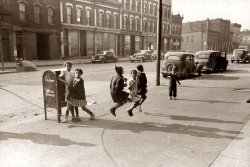
- Cajun Girls' Night Out: 1938
- ... Cajun country at Raceland, Louisiana." 35mm negative by Russell Lee for the Farm Security Administration. View full size.
Horses and ... Posted by Dave - 04/10/2008 - 9:31pm -
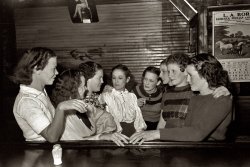
- Drink Joe's Egg Cream: 1936
- ... 38th Street." View full size. 35mm nitrate negative by Russell Lee.
Samson "Yes, gentlemen, you too can have a full head of luxuriant ... Posted by Dave - 09/09/2011 - 6:49pm -
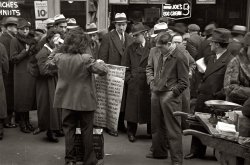
- Edgar's Daughter: 1936
- ... View full size. Medium format negative by Russell Lee for the Resettlement Administration.
Edgar's Daughter How very ... Posted by Dave - 09/09/2011 - 2:38pm -
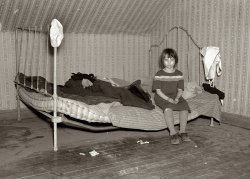
- Twig Trimmer: 1937
- ... of Twig, Minnesota." Medium format nitrate negative by Russell Lee for the Resettlement Administration. View full size.
Barber pole ... Posted by Dave - 11/12/2015 - 9:34pm -
![Twig Trimmer: 1937 August 1937. "Barbershop in village of Twig, Minnesota." Medium format nitrate negative by Russell Lee for the Resettlement Administration. View full size.
Barber poleThere’s either the elegant rotating pole inside a glass tube or, uh, this.
[Not to mention the traditional barber building corner. -tterrace]
At Least It's HeatedExcuse me, may I use your washroom please? Looks like no water or shampoo in this place. Nor a light switch. Oh and by the way, the washroom shack is a few steps out out back, unheated.
[There is, however, free parking. - Dave]
The Old Fashioned WayJudging by the lack of electrical wires and windows (at least from this angle), it looks like this barber does things the old fashioned way: Comb and scissors by lantern light. Hope you're not too picky!
[Half of the storefront is a window! - Dave]
Floyd's Barber Shop in Mayberryis looking positively palatial compared to this.
TwigTwo Minnesota photos in as many days. But whereas Twig is way up near Duluth, Blue Earth (of Minnesota Kodachromes fame) is south of Minneapolis on Interstate 90, almost at the Iowa border.
Pole MatchingIn case a potential customer misses the barber-pole, this barber has a matching barber-corner-of-building.
One ChairLots of waiting, bet many tall tales were heard within those walls.
All GoneScissors and comb have been replaced with propane and nightcrawlers.
Out in the sticksWhen I lived in Minnesota, the joke was "Twig - oh yeah, it's out in the sticks." Looks like it still is. To add to the interesting place names, Minnesota also has a Fertile and a Climax. In journalism class, we were shown an actual headline: "Fertile Woman Dies in Climax."
S. Todd, Barber -> Twig Store Propane and nightcrawlers… I guess you'll see no cries of gentrification here.
Electrical system in a suitcase? You bet.In June, 1938, the "modern" electrical system in my Great Uncle and Aunt's, "The Walton's" style, rural general store in the Missouri Ozarks, consisted of a few light-bulbs, wire, batteries, and a hand-crank generator; all of which would fit in a suitcase. My father, a 12-year old farm-boy, powered the generator as people from all-around listened-in on a new, floor-mounted, upright electric radio to the "fight-of-the-century" between Germany's Max Schmelling and America's Joe Louis.
(The Gallery, Bicycles, Russell Lee, Small Towns)](https://www.shorpy.com/files/images/SHORPY-8b36753a1.thumbnail.jpg)
- Young Gun: 1939
- ... Sonny's suction-cup ammo. Large-format nitrate negative by Russell Lee for the Resettlement Administration. View full size.
Butcher Paper ... Posted by Dave - 01/13/2013 - 8:25pm -
![Young Gun: 1939 January 1939. "Sunflower Plantation. Son of tenant farmer in corner of living room. Pace, Mississippi." Note Sonny's suction-cup ammo. Large-format nitrate negative by Russell Lee for the Resettlement Administration. View full size.
Butcher PaperTterrace we always licked the suction cups before shooting the darts usually at the tv or a window. Glass and foreheads seemed to be the only things that they would stick to.
Suction cup?We don't need no stinking suction cup. The first thing my
brother and I would do is pull the cup off and sharpen the
end in a pencil sharpener. our main targets were cardboard
boxes. I'll leave it at that.
Cool guitar!Melody King, set up for Hawaiian style playing, with the raised nut. Made in Chicago by the Harmony Co., distributed by the Bronson Co., to the best of my understanding. I collect and restore old Harmony guitars.
Streamline!Can anybody identify the toy in the box? Is it a travel trailer, or maybe a bus? And I like the ships wheel motif around the sound hole in the guitar.
No refrigerator hereToo bad because that's the only thing those darts stuck to. My uncle pronounced me "the laziest kid I have ever seen in my whole life" because I had tied thread to my darts so I wouldn't have to get up and go retrieve them.
I had one.Those suction darts would never stick to anything.
[Surely I can't be the only one who spit on the cup and stuck it to my forehead. And got a nice round blue bruise for my trouble. - tterrace]
WallPAPERI just love that "Real McCoy" wall PAPER - likely with no insulation and Tar Paper on the outside. Pity the kid did not have crayons to draw on it.
PowerlessFrom what I can see, there's probably no electricity in the house. The huge "A" battery , and the "B" battery which may be behind it on the chair, probably powered a radio among other things. The AM receiver on the table looks like it was gutted but they may have had another one. It also appears that Our Gang's "Alfalfa" was a relative.
Farm radioThe antenna and ground leads for the radio are visible just to the right of the table; the antenna lead disappears through a hole in the window frame. It's likely the radio is a Silvertone, mail-ordered from Sears and Roebuck, just like the batteries powering it. Prior to the Electrification Act of 1936 these "farm sets" were popular in rural areas; since it took several years for the "high line" to reach many farms they were still offered in the mail order catalogs in 1940.
Streamlined CampingThe toy in the shoe box is a stamped steel toy camping trailer from the All Metal Products Co. in Wyandotte, Mi. It had nickel trim and real rubber wheels.
Hopefully the kid still had the really cool LaSalle sedan that pulled the camper!
Boys and their toysLike this young lad, I also had a suction cup gun that I used to shot at anything and everything. And like this lad probably did, I found out why there was a belt hanging on the wall within easy reach of mom and dad.
Poetry FansI like how the portrait of Emily Dickinson has pride of place for this family.
Farm RadioI believe OldeRadio is correct. The radio appears to be a 1937 Silvertone 4661, seen here: http://radioatticarchives.com/radio.htm?radio=3427 Probably a nice set at that time.
(The Gallery, Kids, Russell Lee)](https://www.shorpy.com/files/images/SHORPY_8b37111a.thumbnail.jpg)
- Red Ryder: 1940
- ... space is evident." Medium format acetate negative by Russell Lee for the Farm Security Administration. View full size.
Same old ... Posted by Dave - 09/19/2018 - 12:31pm -
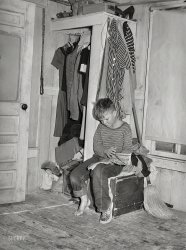
- Walked Eight Miles: 1940
- ... View full size. Medium-format safety negative by Russell Lee.
Ouch All with bare feet? That's definitely dedication.
Pie ... Posted by Dave - 08/10/2012 - 4:55pm -
![Walked Eight Miles: 1940 June 1940. Pie Town, New Mexico. Wife of a homesteader with her WPA (Work Projects Administration) music class. These children walk eight miles for their music lessons. View full size. Medium-format safety negative by Russell Lee.
OuchAll with bare feet? That's definitely dedication.
Pie TownIt appears that the windows are above ground, no dugout here.
Seems unfairIf you walk eight miles to play music, you deserve something better than an accordion.
Pie Town KidsThis image (like so many here) is enormously evocative. The timer, the foot rest and evidence of recent toil on the clothes and bodies of the boys are among a few after just a few seconds viewing.
Can we relate?
That is why we look here. I have been a loyal Plan59 (EphemeraNow) Shorpy.com visitor/customer for the better part of 10 years. The stunning restoration of some of these scans takes a moment years ago and makes it immediate, right now. I feel like I am the first person to view a newly developed slide the day it was captured.
Important work to be sure.
Foy
All that effort on the partAll that effort on the part of all parties just to bring a little civilization to the wilds of New Mexico.
What is astounding is just how much things have changed in a single generation. The experiences of these people pictured are so removed from our own, I wonder how many of us can even pretend to relate.
But if you had to carry itIf you walk eight miles to play music, you deserve something better than an accordion.
But if you had to carry it for eight miles I wouldn't want anything bigger than an accordion.
[I wonder whose turn it was to carry the piano. - Dave]
Walking 8 milesI can't get my grandsons to walk 8 feet!
Kudos all around While I commend the dedication of these future music greats, remember, it is the home environment and the perseverance of the extended family that ultimately motivated these youngsters to sacrifice for their art. How many of our modern youth would walk several miles for anything? I'm sure there are many, but, overall, we have inherited a way of life that, thankfully, no longer requires that kind of exhausting dedication.
(The Gallery, Kids, Music, Pie Town, Rural America, Russell Lee)](https://www.shorpy.com/files/images/8b25210u_0.thumbnail.jpg)
- Shady Rest: 1940
- ... we'll let someone else explain the skirt-brella. Photo by Russell Lee for the Farm Security Administration. View full size.
Wicked Tee ... Posted by Dave - 09/20/2014 - 8:48am -
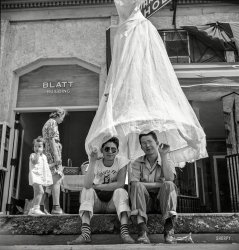
- Hi-Way Tavern: 1939
- ... signage, a gas station. Medium format acetate negative by Russell Lee for the Farm Security Administration. View full size.
Sign of a ... Posted by Dave - 03/07/2018 - 11:02am -
![Hi-Way Tavern: 1939 March 1939. "Signs in front of highway tavern. Crystal City, Texas." And, somewhere back there amid the signage, a gas station. Medium format acetate negative by Russell Lee for the Farm Security Administration. View full size.
Sign of a womanAlways nice to see a woman's touch. The family must live upstairs; hence the potted plant and a towel hanging on the line.
Home of Popeye the SailorAt the time, Crystal City's main economic engine was the cultivation of spinach, and March of 1939 was the two year anniversary of the installation in front of city hall of the statue of Popeye the Sailor. The statue was erected to celebrate the economic contribution of spinach to the local economy, which was especially important to the city during the Depression. The statue still stands, and Crystal City hosts the annual Spinach Festival every November.
https://www.roadsideamerica.com/story/2658
Blatz BeerWhen you're drinking for Quantity not Quality.
Color me impressedThis would be a good candidate for colorization.
Delaware PunchI haven't had a Delaware Punch in decades. Do they still make that?
Long-lasting brands!Let's see:
7up - check
Dr. Pepper - check
Delaware Punch - check
Coca-Cola - check
Budweiser - check
Pearl beer - check
Blatz beer - check
Gulf oil - check
I believe the only brand name not in use today is Grand Prize beer. Pretty impressive 8 for 9 in an 80-year-old photo!!
[Or 9 for 10 if we count the Orange Crush sign. - Dave]
Very collectible signs, allAny collectors want to estimate the combined value of all those signs in today's market?
OK, I give up.Where's the Orange Crush?
[Between the 7ups. -tterrace]
Although I do spy half of a Nehi sign in the shadows (left of Blatz Beer).
Add NehiThat makes 10/11.
Never Heard This One BeforeFound out that Delaware Punch was named for one of its main ingredients, the Delaware grape. Then found out the Delaware grape is named for Delaware County, Ohio, where it was first grown--and where I happen to live.
I Am SaddenedThey don't have Squirt advertised. Very popular during the early and middle 40's. But Squirt wasn't made until about 1938 so, maybe, the popularity of the soda had not made its way to this location yet in 1939.
Grand Prize not so grandMy grandfather worked for a Grand Prize distributor in southeast Texas in the 1950s and he always said its taste left a lot to be desired. As Pennsylvaniaproud said, quantity over quality.
On a side note, the Gulf Brewing Company, makers of Grand Prize, was once owned by Howard Hughes.
(The Gallery, Eateries & Bars, Gas Stations, Rural America, Russell Lee)](https://www.shorpy.com/files/images/SHORPY-8b21169a.thumbnail.jpg)
- Dakota Drug: 1937
- ... Stanley, North Dakota." Medium-format nitrate negative by Russell Lee for the Resettlement Administration. View full size.
Could this be ... Posted by Dave - 07/09/2013 - 4:12pm -
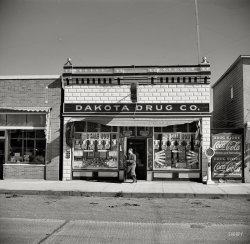
- Gonzales: 1939
- ... of Gonzales, Texas." Medium format acetate negative by Russell Lee for the Farm Security Administration. View full size.
Teutonic ... to $19.55 STORE"
(The Gallery, Cars, Trucks, Buses, Russell Lee, Small Towns, Stores & Markets) ... Posted by Dave - 08/02/2021 - 3:18pm -
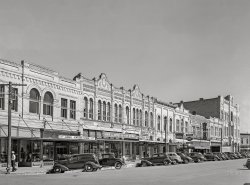
- Loves a Parade: 1938
- ... Festival parade in Crowley, Louisiana." 35mm negative by Russell Lee, Farm Security Administration. View full size.
Joy from little ones ... Posted by Dave - 03/16/2012 - 9:14pm -
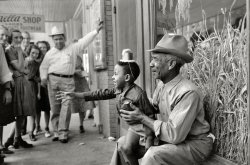
- Pie Town Garden: 1940
- ... Mexico. View full size. 4x5 Kodachrome transparency: Russell Lee.
Tobacco? Are those plants with the big leaves tobacco?
Re: ... Posted by Dave - 08/30/2012 - 12:01pm -
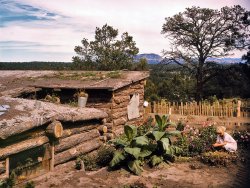
- Summer Games: 1941
- ... in Vale, Oregon." Medium format acetate negative by Russell Lee. View full size.
De-Colorization This could be a black and white ... Posted by Dave - 10/19/2018 - 1:30pm -
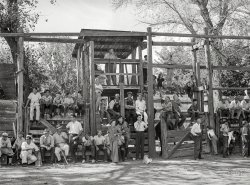
- Tintype Cowboy: 1939
- ... cameraman on a San Antonio, Texas, street. Photo by Russell Lee, March, 1939. View full size.
Sort Of An Early Polaroid... I ... Posted by Ken - 09/08/2011 - 8:43pm -
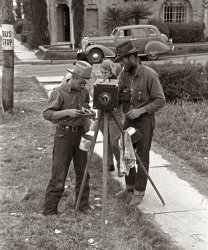
- Pop Shop: 1940
- ... at Central Valley, California." Medium format negative by Russell Lee for the Farm Security Administration. View full size.
Colas Big ... Posted by Dave - 02/12/2019 - 3:15pm -
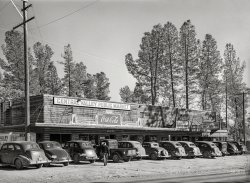
- Snappy Lunch: 1940
- ... Second largest gold section in the state." Photo by Russell Lee for the Farm Security Admin. View full size.
Feeling hungry? My ... Posted by Dave - 08/15/2018 - 1:38pm -
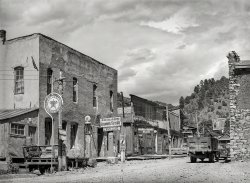
- On the House: 1937
- ... Minnesota." Where everyone knows your name. Photo by Russell Lee for the Resettlement Administration. View full size.
Rolling Your ... was trying to tell us.
(The Gallery, Eateries & Bars, Russell Lee) ... Posted by Dave - 12/29/2012 - 9:05am -
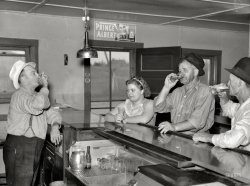
- You Just Got to Hustle: 1940
- ... done plenty of that."
Medium format negative by Russell Lee. View full size.
Come back in a year There will be more work ... Posted by Dave - 01/29/2019 - 3:38pm -
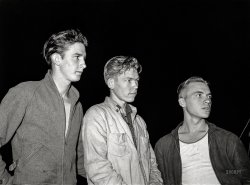
- Corporal Nourishment: 1942
- ... his girl to dinner. Bakersfield, California." Photo by Russell Lee, Office of War Information. View full size.
If he's lucky ... Posted by Dave - 04/09/2013 - 9:41am -
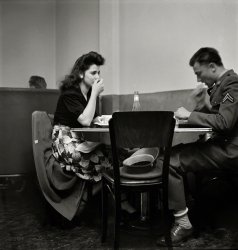
- Carlton's Pharmacy: 1940
- ... Shasta County, California." Medium format negative by Russell Lee. View full size.
What's a girl to do Oh dear. To the left ... Posted by Dave - 02/12/2019 - 11:59am -
![Carlton's Pharmacy: 1940 November 1940. "Boomtown store near Shasta Dam construction site, Shasta County, California." Medium format negative by Russell Lee. View full size.
What's a girl to doOh dear. To the left of the door we have a full-length view of a larger lass clad only in her smalls, standing on a scale, urged to take diet supplements ... early body shaming? To the right we're treated to a closeup of a gorgeous gal looking longingly at a Whitman's Sampler, the box being proffered by the hand of a gallant gentleman. Such conflict. Keep the scale and the vitamins; I'll take the chocolates.
Whitman'sThank you, Whitman's chocolate, for refusing to bow to pressure about modern design and the need to "rebrand." I recognize your box across time, and hope that it had good chocolates within.
Fresh MagazinesThat's the December 1940 issue of Movie Life Magazine top left of the rack, with Claudette Colbert and Ray Milland on the cover.
Most likely promoting their 1941 Comedy, Skylark.
Alka Seltzer ThermometerAs a collector of advertising thermometers, I have never seen a tin Alka-Seltzer. Several PAM type with Speedy very collectible. Tin nice shape bulb works no nail hole damage. That's a real gem there. Wish I had it.
Battle of TarantoA precursor to the Japanese attack on Pearl Harbor -- the British Royal Navy used carrier-based torpedo bombers to attack Italian Navy vessels in the port at Taranto on the night of 11/12 November 1940.
https://en.wikipedia.org/wiki/Battle_of_Taranto
Safely distantThe bombing of Italy's fleet at Taranto must have made for interesting reading when we were still safely thousands of miles and more than a year removed from the war.
Extra! Extra!As you can see, the San Francisco Chronicle and the rival Examiner are keeping a certain wary but respectful distance between one another at opposite ends of the porch. No one make any sudden moves.
Read All About ItIt looks like the major headline of the day is about Britain's attack on the Italian fleet at Taranto, which occurred on the night of November 11-12, 1940.
Life on Mars with ChocolateIf man ever does reach the point of living on Mars, there will, no doubt, be a retro Rexall Drug Store there selling Whitman's Samplers.
But by that time there will probably only be one piece of candy per level in the box. I bought a box recently and was disappointed to find maybe eight pieces on each of the two levels, instead of the filled box assortment of yesteryear.
What's hanging up top?On the peak of the roof there is a device I can't identify. It's restrained by a guy wire on each side. Any guesses?
[A neon "Rexall" sign. - Dave]
Maybe not so much silver screenbut we do have Russell Sambrook's painting "Catch the Turkey" on the cover of Liberty's November 23rd issue, "Springer Spaniel" by W.W. Calvert on the Saturday Evening Post of the 16th, and a slightly jumping-the-gun December 1940 issue of McCall's, with the beginning of a four-part serial "The Beautiful Southwick Girls" by Margaret Culkin Banning, subtitled "a story of how much — and how little — men think of beautiful women." (Banning was a well-known women's rights activist as well as a hot-selling author.)
Miss PopularityAmongst other stars:
Jimmy Stewart, Katharine Hepburn and Cary Grant in Screen Romances 12/40.
Linda Darnell in Silver Screen 12/40.
Linda Darnell (again) in Movie Mirror 12/40.
Paulette Goddard on set, Motion Picture 12/40.
Tyrone Power and Linda Darnell (yet again) “Mark of Zorro” in Screenland 12/40.
17-year-old Linda wins the popularity poll, and is at the peak of her stardom.
The news stands in colorAnd thanks to Vintagetvs, I missed the Movie Life issue.
More Than 30 Comics!Oh, how I long for those days. At two comics per page, that was probably a 16-page section. (When I was in high school I remember hearing a rumor that the Denver Post Comic Section was so huge you could subscribe to it alone!) Today the comics are barely an afterthought - the strips are smaller and you're lucky if you get 4 pages on Sunday. Breaks my heart.
(The Gallery, Russell Lee, Stores & Markets)](https://www.shorpy.com/files/images/SHORPY-8c00127a.thumbnail.jpg)
- Home Alone: 1937
- ... house near Ambrose, Divide County, North Dakota." Photo by Russell Lee for the Farm Security Administration. View full size.
TILT All ... Posted by Dave - 03/02/2018 - 12:30pm -
